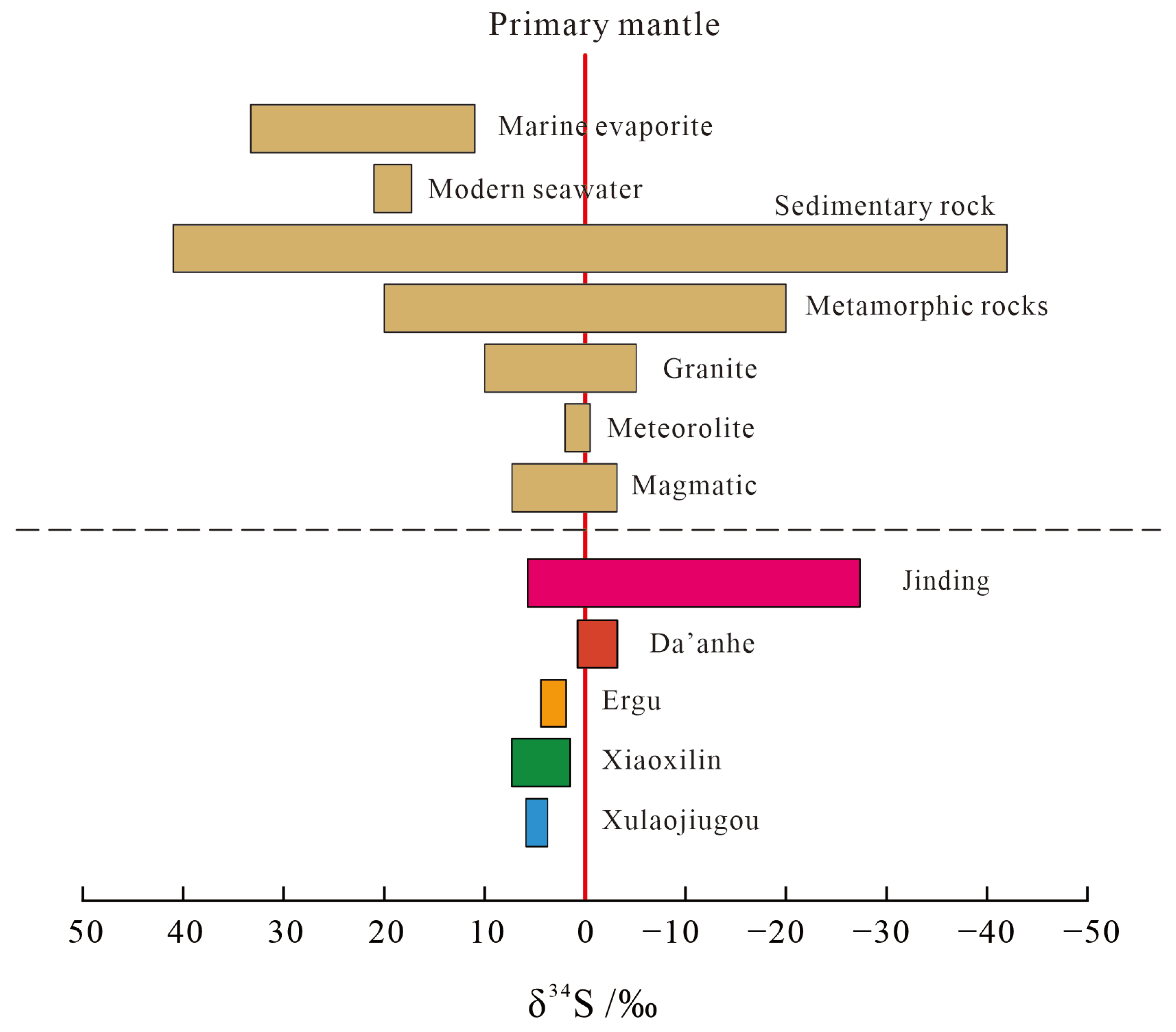Origin of the Xulaojiugou Pb–Zn Deposit, Heilongjiang Province, NE China: Constraints from Molybdenite Re–Os Isotopic Dating, Trace Elements, and Isotopic Compositions of Sulfides
Abstract
1. Introduction
2. Regional Geology
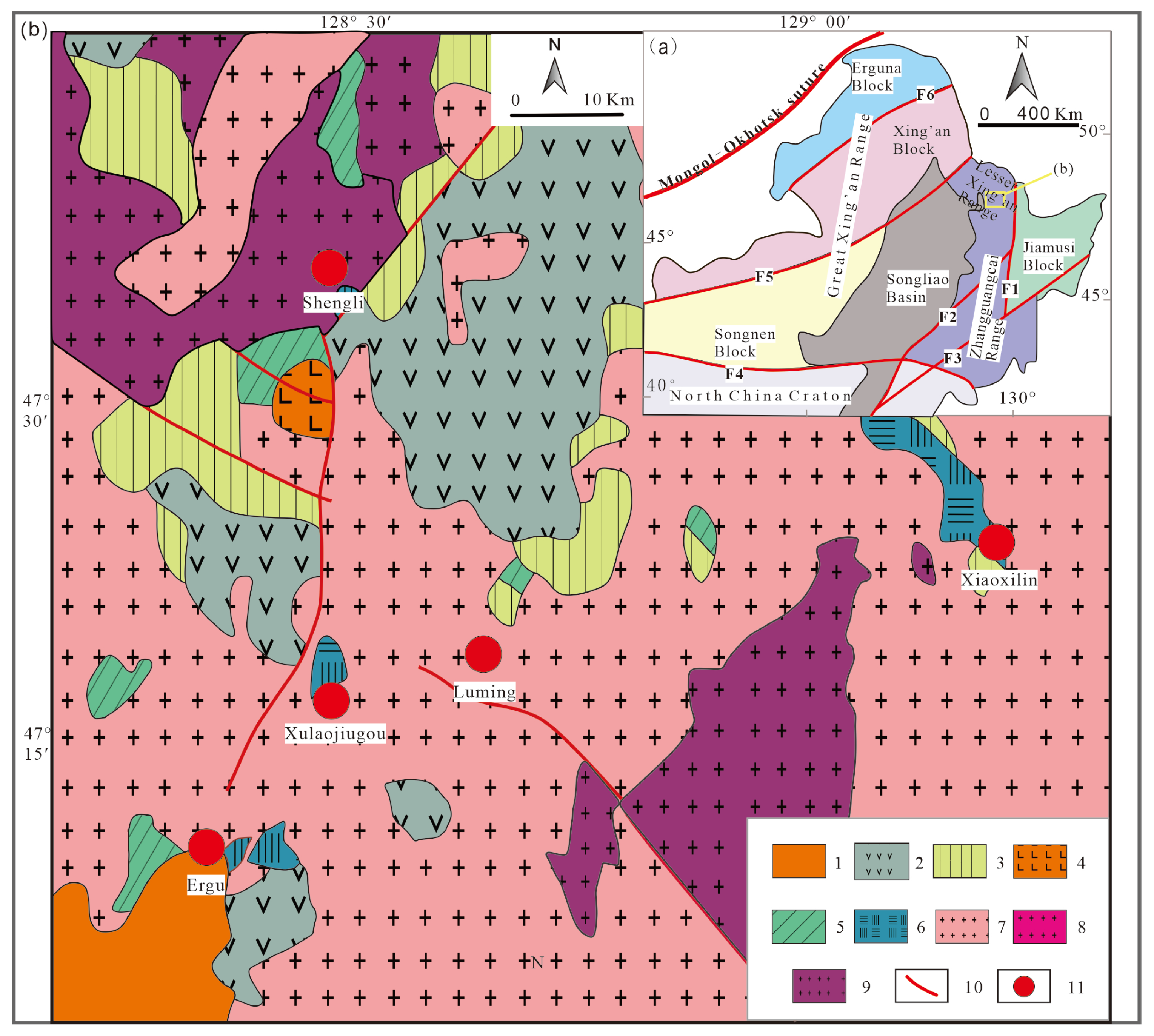
3. Deposit Geology
4. Sample Description and Analytical Methods
4.1. Sample Description
4.2. Analysis Methods
4.2.1. Molybdenite Re–Os Isotopic Analyses
4.2.2. In Situ Sulfur Isotope Analysis
4.2.3. EPMA
4.2.4. LA-ICP-MS
5. Results
5.1. Molybdenite Re–Os Isotope Ages
5.2. In Situ Sulfur Isotopes
5.3. The Major and Trace Elements of Sphalerite
6. Discussion
6.1. Timing of Magmatism and Mineralization
6.2. Source of Ore-Forming Materials
6.3. Ore-Forming Temperature
6.4. Genetic Type and Metallogenic Processes
7. Conclusions
- The Re–Os isochron age of the molybdenite (184.6 ± 3.0 Ma, MSWD = 0.41) indicates that the Xulaojiugou Pb–Zn deposit was formed in the Early Jurassic, and its mineralization is related to the subduction of the Paleo-Pacific plate.
- Geochemical analysis of rocks reveals that the major and trace element composition characteristics of sphalerite in the deposit are highly consistent with those of typical skarn deposits in China. This geochemical signature further supports the spatial association of the ore bodies with the contact zone between medium-grained monzogranite and marbles.
- Sulfur isotope analysis exhibited homogeneous δ34S values ranging from 5.31‰ to 5.83‰ in sphalerite and 4.70‰ to 5.68‰ in galena, with sulfur source tracing confirming predominant derivation from the deep magmatic source area.
- In situ trace element analysis of sphalerite in the Xulaojiugou Pb–Zn deposit shows that the Zn/Cd, Ga/In ratios indicate a mesothermal environment during mineralization, specifically within the range of 248–262 °C.
Author Contributions
Funding
Data Availability Statement
Acknowledgments
Conflicts of Interest
References
- Sun, J.G.; Zhang, Y.; Xing, S.W.; Zhao, K.Q.; Zhang, Z.J.; Bai, L.A.; Ma, Y.B.; Liu, Y.S. Genetic types, ore-forming age and geodynamic setting of endogenic molybdenum deposits in the eastern edge of Xing-Meng orogenic belt. Acta Petrol. Sin. 2012, 28, 1317–1332, (In Chinese with English Abstract). [Google Scholar]
- Ouyang, H.; Mao, J.; Santosh, M.; Zhou, J.; Zhou, Z.; Wu, Y.; Hou, L. Geodynamic Setting of Mesozoic Magmatism in NE China and Surrounding Regions: Perspectives from Spatio-Temporal Distribution Patterns of Ore Deposits. J. Asian Earth Sci. 2013, 78, 222–236. [Google Scholar] [CrossRef]
- Wang, Z.J. Late Paleozoic-Triassic Tectonic Evolution of Eastern Segment of the Southern Margin of the Xing’an–Mongolia Orogenic Belt: Evidence from Detrital zircon U-Pb Geochronology and Igneou Srock Associations. Ph.D. Thesis, Jilin University, Changchun, China, 2016. (In Chinese with English Abstract). [Google Scholar]
- Ren, L.; Sun, J.; Han, J.; Liu, Y.; Wang, C.; Gu, A.; Zhao, K.; Yu, R. Magmatism and Metallogenic Mechanisms of the Baoshan Cu-Polymetallic Deposit from the Lesser Xing’an Range, NE China: Constraints from Geology, Geochronology, Geochemistry, and Hf Isotopes. Ore Geol. Rev. 2017, 88, 270–288. [Google Scholar] [CrossRef]
- Han, Z.Z.; Zhao, H.L.; Li, J.J.; Luo, J.; Zhang, W.L.; Li, W.L. Metallogenic Prognosis of Porphyry Style Molybdenum Mineralization Potential in Xing’an Area, Tieli City, Heilongjiang Province. Geol. Explor. 2009, 45, 253–259, (In Chinese with English Abstract). [Google Scholar]
- Ji, R. Geological Characterisitics and Genesis Mechanism of the Xulaojiugou Pb–Zn Deposit, Heilongjiang Province. Master’s Thesis, Jilin University, Changchun, China, 2015. (In Chinese with English Abstract). [Google Scholar]
- Hu, X.; Yao, S.; Zeng, G.; Liu, W.; Zhang, Z. Multistage Magmatism Resulting in Large-Scale Mineralizaion: A Case from the Huojihe Porphyry Mo Deposit in NE China. Lithos 2019, 326–327, 397–414. [Google Scholar] [CrossRef]
- Han, Z.Z.; Zhao, H.L.; Li, J.J.; Leng, C.E.; Lü, J.; Li, W.L. Early Mesozoic granites and polymetallic mineralization in southeastern Yichun area, Xiao Hinggan Mountains. China Geol. 2010, 37, 74–87, (In Chinese with English Abstract). [Google Scholar]
- Chen, Y.J.; Zhai, M.G.; Jiang, S.Y. Significant achievements and open issues in study of orogenesis and metallogenesis surrounding the North China continent. Acta Petrol. Sin. 2009, 25, 2695–2726, (In Chinese with English Abstract). [Google Scholar]
- Zhang, X.Z.; Ma, Y.X.; Chi, X.G.; Zhang, F.X.; Sun, Y.W.; Guo, Y.; Zeng, Z. Discussion on Phanerozoic Tectonic Evolution in Northeastern China. J. Jilin Univ. (Earth Sci. Ed.) 2012, 42, 1269–1285, (In Chinese with English Abstract). [Google Scholar] [CrossRef]
- Zhou, J.B.; Pu, X.G.; Hou, H.S.; Han, W.; Cao, J.L.; Li, G.Y. The Mesozoic accretionary complex in NE China and its tectonic implications for the subduction of the Paleo-Pacific plate beneath the Eurasia. Acta Petrol. Sin. 2018, 34, 2845–2856, (In Chinese with English Abstract). [Google Scholar]
- Zhang, Z.; Mao, J.; Wang, Y.; Pirajno, F.; Liu, J.; Zhao, Z. Geochemistry and Geochronology of the Volcanic Rocks Associated with the Dong’an Adularia–Sericite Epithermal Gold Deposit, Lesser Hinggan Range, Heilongjiang Province, NE China: Constraints on the Metallogenesis. Ore Geol. Rev. 2010, 37, 158–174. [Google Scholar] [CrossRef]
- Hu, X.; Ding, Z.; He, M.; Yao, S.; Zhu, B.; Shen, J.; Chen, B. A Porphyry-Skarn Metallogenic System in the Lesser Xing’an Range, NE China: Implications from U–Pb and Re–Os Geochronology and Sr–Nd–Hf Isotopes of the Luming Mo and Xulaojiugou Pb–Zn Deposits. J. Asian Earth Sci. 2014, 90, 88–100. [Google Scholar] [CrossRef]
- Wu, F.; Yang, J.; Lo, C.; Wilde, S.A.; Sun, D.; Jahn, B. The Heilongjiang Group: A Jurassic Accretionary Complex in the Jiamusi Massif at the Western Pacific Margin of Northeastern China. Isl. Arc 2007, 16, 156–172. [Google Scholar] [CrossRef]
- Yang, Y.C.; Han, S.J.; Sun, D.Y.; Guo, J.; Zhang, S.J. Geological and geochemical features and geochronology of porphyry molybdenum deposits in the Lesser Xin’an Range-Zhangguangcai Range metallogenic belt. Acta Petrol. Sin. 2012, 28, 379–390, (In Chinese with English Abstract). [Google Scholar]
- Shi, D.F.; Chen, D.S.; Zhu, Y.; Li, G.X.; Zhang, D.X.; Liu, Y.; Yang, X.; Lu, Y.L. Trace element characteristics of sulfides from Dingjiashan Pb–Zn deposit in Meixian of central Fujian Province and their metallogenic significance. Miner. Deposits. 2021, 40, 432–448, (In Chinese with English Abstract). [Google Scholar] [CrossRef]
- Zhang, S.; Kou, L.L.; Han, R.P.; Liu, G.X.; Pang, W.L.; Lü, J.C.; Tan, H.Y. Metallogeny and zircon U-Pb age of ore-bearing granodiorite of the Huojihe molybdenum deposit in Heilongjiang Province. Geol. Resour. 2013, 22, 169–173, (In Chinese with English Abstract). [Google Scholar] [CrossRef]
- Fei, X.; Zhang, Z.; Cheng, Z.; Santosh, M.; Jin, Z.; Wen, B.; Li, Z.; Xu, L. Highly Differentiated Magmas Linked with Polymetallic Mineralization: A Case Study from the Cuihongshan Granitic Intrusions, Lesser Xing’an Range, NE China. Lithos 2018, 302–303, 158–177. [Google Scholar] [CrossRef]
- Zhao, C.; Sun, J.; Chu, X.; Qin, K.; Ren, L.; Xu, Z.; Liu, Y.; Han, J.; Bai, C.; Shu, W. Metallogeny of the Ergu Fe-Zn Polymetallic Deposit, Central Lesser Xing’an Range, NE China: Evidence from Skarn Mineralogy, Fluid Inclusions and H-O-S-Pb Isotopes. Ore Geol. Rev. 2021, 135, 104227. [Google Scholar] [CrossRef]
- Qu, W.J.; Du, A.D. Highly Precise Re–Os Dating of Molybdenite by ICP-MS with Carius Tube Sample Digestion. Rock Miner. Anal. 2003, 22, 254–257, 262, (In Chinese with English Abstract). [Google Scholar]
- Li, C.; Qu, W.J.; Du, A.D.; Sun, W.J. Comprehensive Study on Extraction of Rhenium with Acetone in Re–Os Isotopic Dating. Rock Miner. Anal. 2009, 28, 233–238, (In Chinese with English Abstract). [Google Scholar]
- Li, C.; Qu, W.J.; Zhou, L.M.; Du, A.D. Rapid Separation of Osmium by Direct Distillation with Carius Tube. Rock Miner. Anal. 2010, 29, 14–16, (In Chinese with English Abstract). [Google Scholar] [CrossRef]
- Smoliar, M.I.; Walker, R.J.; Morgan, J.W. Re–Os Ages of Group IIA, IIIA, IVA, and IVB Iron Meteorites. Science 1996, 271, 1099–1102. [Google Scholar] [CrossRef]
- Chen, L.; Chen, K.; Bao, Z.; Liang, P.; Sun, T.; Yuan, H. Preparation of Standards for in Situ Sulfur Isotope Measurement in Sulfides Using Femtosecond Laser Ablation MC-ICP-MS. J. Anal. At. Spectrom. 2017, 32, 107–116. [Google Scholar] [CrossRef]
- Bao, Z.; Chen, L.; Zong, C.; Yuan, H.; Chen, K.; Dai, M. Development of Pressed Sulfide Powder Tablets for in Situ Sulfur and Lead Isotope Measurement Using LA-MC-ICP-MS. Int. J. Mass Spectrom. 2017, 421, 255–262. [Google Scholar] [CrossRef]
- Liu, Y.; Hu, Z.; Gao, S.; Günther, D.; Xu, J.; Gao, C.; Chen, H. In Situ Analysis of Major and Trace Elements of Anhydrous Minerals by LA-ICP-MS without Applying an Internal Standard. Chem. Geol. 2008, 257, 34–43. [Google Scholar] [CrossRef]
- Stein, H.J.; Markey, R.J.; Morgan, J.W.; Hannah, J.L.; Scherstén, A. The Remarkable Re–Os Chronometer in Molybdenite: How and Why It Works. Terra Nova 2001, 13, 479–486. [Google Scholar] [CrossRef]
- Schaltegger, U.; Schmitt, A.K.; Horstwood, M.S.A. U–Th–Pb Zircon Geochronology by ID-TIMS, SIMS, and Laser Ablation ICP-MS: Recipes, Interpretations, and Opportunities. Chem. Geol. 2015, 402, 89–110. [Google Scholar] [CrossRef]
- Tan, H.Y. Metallogenetic Series and Prospecting Assessment in Lesser Xing’an Range-Zhanggangcai Rang Metallogenic Belt of Heilongjiang Province. Ph.D. Thesis, China University of Geosciences, Beijing, China, 2013. (In Chinese with English Abstract). [Google Scholar]
- Huang, W.P. Genesis and Metallogenic Prediction of Xiaoxilin Pb–Zn Deposit, Yichun City, Heilongjiang Province. Master’s Thesis, Jilin University, Changchun, China, 2013. (In Chinese with English Abstract). [Google Scholar]
- Chu, C.G. Geological Characterisitcs and Ore Genesis of Erguxishan Fe Polymetallic Deposit in Tieli Area, Heilongjiang Province. Master’s Thesis, Jilin University, Changchun, China, 2016. (In Chinese with English Abstract). [Google Scholar]
- Ohmoto, H. Systematics of Sulfur and Carbon Isotopes in Hydrothermal Ore Deposits. Econ. Geol. 1972, 67, 551–578. [Google Scholar] [CrossRef]
- Ferrini, V.; Fayek, M.; De Vito, C.; Mignardi, S.; Pignatti, J. Extreme Sulphur Isotope Fractionation in the Deep Cretaceous Biosphere. J. Geol. Soc. 2010, 167, 1009–1018. [Google Scholar] [CrossRef]
- Ohmoto, H.; Rye, R.O. Isotopes of Sulfur and Carbon. In Geochemistry of Hydrothermal Ore Deposit, 2nd ed.; Barnes, H.L., Ed.; John Wiley and Sons: New York, NY, USA, 1979; pp. 509–567. [Google Scholar]
- Du, S.M. Application of sulfur isotopes in tracing the source of metallogenic materials in metal deposits. Geol. Chem. Miner. 2019, 41, 196–202, (In Chinese with English Abstract). [Google Scholar]
- Green, C.T.; Böhlke, J.K.; Bekins, B.A.; Phillips, S.P. Mixing Effects on Apparent Reaction Rates and Isotope Fractionation during Denitrification in a Heterogeneous Aquifer. Water Resour. Res. 2010, 46, 2009WR008903. [Google Scholar] [CrossRef]
- Yang, F. The Study on Mineralzaion and Metallogenic Background of Da’anhegold Deposit in Yichun, Heilongjiang Province. Master’s Thesis, Jilin University, Changchun, China, 2013. (In Chinese with English Abstract). [Google Scholar]
- Chaussidon, M.; Albarède, F.; Sheppard, S.M.F. Sulphur Isotope Variations in the Mantle from Ion Microprobe Analyses of Micro-Sulphide Inclusions. Earth Planet. Sci. Lett. 1989, 92, 144–156. [Google Scholar] [CrossRef]
- Li, J.-L.; Schwarzenbach, E.M.; John, T.; Ague, J.J.; Huang, F.; Gao, J.; Klemd, R.; Whitehouse, M.J.; Wang, X.-S. Uncovering and Quantifying the Subduction Zone Sulfur Cycle from the Slab Perspective. Nat. Commun. 2020, 11, 514. [Google Scholar] [CrossRef]
- Tomkins, A.G.; Evans, K.A. Separate Zones of Sulfate and Sulfide Release from Subducted Mafic Oceanic Crust. Earth Planet. Sci. Lett. 2015, 428, 73–83. [Google Scholar] [CrossRef]
- Li, X.C.; Wang, J.B.; Zhu, X.Y.; Li, C.H.; Wu, J.J.; Wang, Y.B.; Shi, M.; Guo, Y.H. Precise discrimination on the mineralization processes of the Jinding Pb–Zn deposit, Lanping Basin, western Yunnan, China: Evidence from in situ trace elements and S-Pb isotopes of sulfides. Acta Petrol. Sin. 2023, 39, 2511–2532, (In Chinese with English Abstract). [Google Scholar] [CrossRef]
- Möller, P. Correlation of Homogenization Temperatures of Accessory Minerals from Sphalerite-Bearing Deposits and Ga/Ge Model Temperatures. Chem. Geol. 1987, 61, 153–159. [Google Scholar] [CrossRef]
- Ye, L.; Liu, T.G. Distribution and occurrence of cadmium in the Niujiaotang Cd-rich zinc deposit, Duyun, Guizhou Province, China. Acta Mineral. Sin. 2001, 21, 115–118, (In Chinese with English Abstract). [Google Scholar] [CrossRef]
- Frenzel, M.; Voudouris, P.; Cook, N.J.; Ciobanu, C.L.; Gilbert, S.; Wade, B.P. Evolution of a Hydrothermal Ore-Forming System Recorded by Sulfide Mineral Chemistry: A Case Study from the Plaka Pb–Zn–Ag Deposit, Lavrion, Greece. Miner. Depos. 2022, 57, 417–438. [Google Scholar] [CrossRef]
- Frenzel, M.; Hirsch, T.; Gutzmer, J. Gallium, Germanium, Indium, and Other Trace and Minor Elements in Sphalerite as a Function of Deposit Type—A Meta-Analysis. Ore Geol. Rev. 2016, 76, 52–78. [Google Scholar] [CrossRef]
- Wang, K.; Wang, Y.; Deng, J.; Liu, J.; Zhang, F.; Zhang, W.; Zhang, H.; Gu, W.; Chen, H. Geology and Genesis of the Aqishan Pb–Zn Deposit, NW China: Insights from Mineralogy, Geochemistry, and in Situ U-Pb Geochronology. Geosci. Front. 2024, 15, 101877. [Google Scholar] [CrossRef]
- Yuan, B.; Mao, J.W.; Yan, X.H.; Wu, Y.; Zhang, F.; Zhao, L.L. Sources of metallogenic materials and metallogenic mechanism of Daliangzi Ore Field in Sichuan Province: Constraints from geochemistry of S, C, H, O, Sr isotope and trace element in sphalerite. Acta Petrol. Sin. 2014, 30, 209–220, (In Chinese with English Abstract). [Google Scholar]
- Ye, L.; Cook, N.J.; Ciobanu, C.L.; Yuping, L.; Qian, Z.; Tiegeng, L.; Wei, G.; Yulong, Y.; Danyushevskiy, L. Trace and Minor Elements in Sphalerite from Base Metal Deposits in South China: A LA-ICPMS Study. Ore Geol. Rev. 2011, 39, 188–217. [Google Scholar] [CrossRef]
- Keith, M.; Haase, K.M.; Schwarz-Schampera, U.; Klemd, R.; Petersen, S.; Bach, W. Effects of Temperature, Sulfur, and Oxygen Fugacity on the Composition of Sphalerite from Submarine Hydrothermal Vents. Geology 2014, 42, 699–702. [Google Scholar] [CrossRef]
- Zou, Z.C.; Hu, R.Z.; Bi, X.W.; Ye, L.; Wu, L.Y.; Feng, C.X.; Tang, Y.Y. Trace element geochemistry of the Liziping Pb–Zn deposit, the Lanping Basin, Northwest Yunnan Province, China. Geochimica 2012, 41, 482–496, (In Chinese with English Abstract). [Google Scholar] [CrossRef]
- Deng, J.; Wang, C.; Bagas, L.; Selvaraja, V.; Jeon, H.; Wu, B.; Yang, L. Insights into Ore Genesis of the Jinding Zn–Pb Deposit, Yunnan Province, China: Evidence from Zn and in-Situ S Isotopes. Ore Geol. Rev. 2017, 90, 943–957. [Google Scholar] [CrossRef]
- Zhao, J.S.; Qiu, X.L.; Zhao, B.; Tu, X.L.; Yu, J.; Lu, T.S. REE geochemistry of mineralized skarns from Daye to Wushan region. Geochimica 2007, 36, 400–412, (In Chinese with English Abstract). [Google Scholar] [CrossRef]
- Song, X.X. Trace elements and their ratios in sphalerite and galena from the Fankou deposit—A comparative study. Rock Miner. Anal. 1982, 1, 37–44, (In Chinese with English Abstract). [Google Scholar]
- Cook, N.J.; Ciobanu, C.L.; Pring, A.; Skinner, W.; Shimizu, M.; Danyushevsky, L.; Saini-Eidukat, B.; Melcher, F. Trace and Minor Elements in Sphalerite: A LA-ICPMS Study. Geochim. Cosmochim. Acta 2009, 73, 4761–4791. [Google Scholar] [CrossRef]
- George, L.L.; Cook, N.J.; Ciobanu, C.L. Partitioning of Trace Elements in Co-Crystallized Sphalerite–Galena–Chalcopyrite Hydrothermal Ores. Ore Geol. Rev. 2016, 77, 97–116. [Google Scholar] [CrossRef]
- Kang, K. Geological, Geochemical Characteristics and Its Genesis of the Huaniushan Pb–Zn Deposit, Beishan, Gansu Province. Master’s Thesis, China University of Geosciences, Beijing, China, 2020. (In Chinese with English Abstract). [Google Scholar]
- Lan, B.Y.; Yuan, F.; Deng, Y.F.; Cheng, P.S.; Li, X.H.; Zhang, J.M.; Li, Z. In situ trace element composition of sphalerite and ore-forming fluid characteristics of Xiwan Pb–Zn deposit, Anhui Province. Mineral. Depos. 2023, 42, 192–210, (In Chinese with English Abstract). [Google Scholar]
- Wu, Y.; Kong, Z.G.; Chen, M.H.; Zhang, C.Q.; Cao, L.; Tang, Y.J.; Yuan, X.; Zhang, P. Trace elements in sphalerites from the Mississippi Valley-type lead-zinc deposits around the margins of Yangtze Block and its geological implications: A LA-ICPMS study. Acta Petrol. Sin. 2019, 35, 3443–3460, (In Chinese with English Abstract). [Google Scholar]
- Lawrence, D. Meinert Application of Skarn Deposit Zonation Models to Mineral Exploration. Explor. Min. Geol. 1998, 6, 185–208. [Google Scholar]
- Zhao, F.; Suo, Y.; Liu, L.; Cao, X.; Li, S.; Jiang, S.; Deng, J.; Dai, M.; Liu, Y.; Hu, Y.; et al. Fine Lithospheric Structure Controlling Meso-Cenozoic Tectono-Magmatism in the South China Block: Inference from a Multidisciplinary Analysis. Earth-Sci. Rev. 2023, 244, 104524. [Google Scholar] [CrossRef]
- Wang, Z.; Wang, K.; Wan, D.; Konare, Y.; Yang, T.; Liang, Y. Metallogenic Age and Hydrothermal Evolution of the Jidetun Mo Deposit in Central Jilin Province, Northeast China: Evidence from Fluid Inclusions, Isotope Systematics, and Geochronology. Ore Geol. Rev. 2017, 89, 731–751. [Google Scholar] [CrossRef]
- Sun, P.; Guo, P.; Niu, Y. Eastern China Continental Lithosphere Thinning Is a Consequence of Paleo-Pacific Plate Subduction: A Review and New Perspectives. Earth-Sci. Rev. 2021, 218, 103680. [Google Scholar] [CrossRef]
- Ji, Z.; Meng, Q.; Wan, C.; Zhu, D.; Ge, W.; Zhang, Y.; Yang, H.; Dong, Y. Geodynamic Evolution of Flat-Slab Subduction of Paleo-Pacific Plate: Constraints From Jurassic Adakitic Lavas in the Hailar Basin, NE China. Tectonics 2019, 38, 4301–4319. [Google Scholar] [CrossRef]
- Chen, X.; Wang, Z.; Yu, P.; Wu, Y.; Huang, Y.; Tan, Z.; Zheng, Y. Physicochemical Condition of the Dafang Skarn Au-Ag-Zn-Pb Polymetallic Deposit in the Nanling Metallogenic Belt (South China), a Perspective from Sphalerite Mineralogy and Geochemistry. Ore Geol. Rev. 2024, 165, 105923. [Google Scholar] [CrossRef]

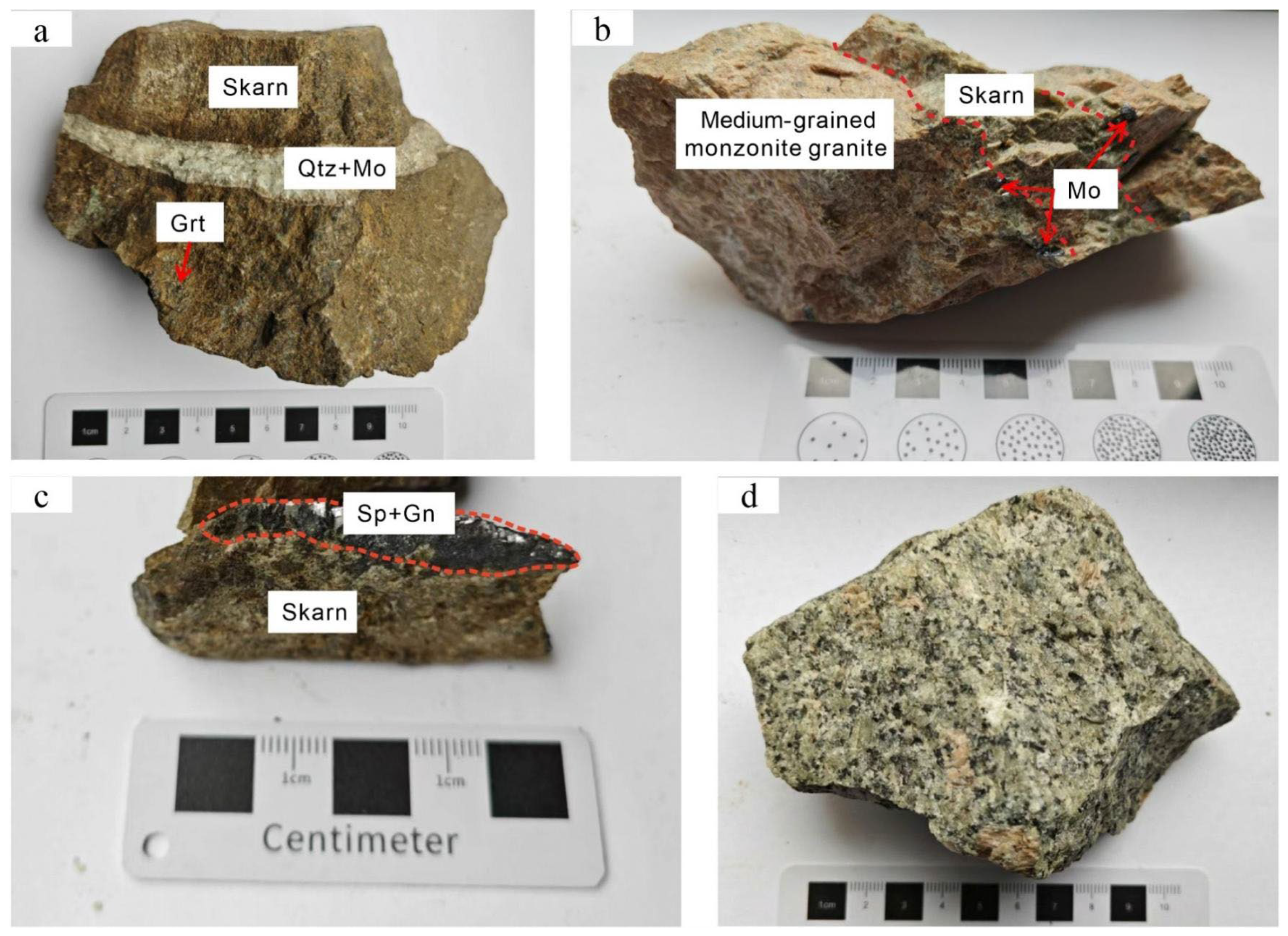


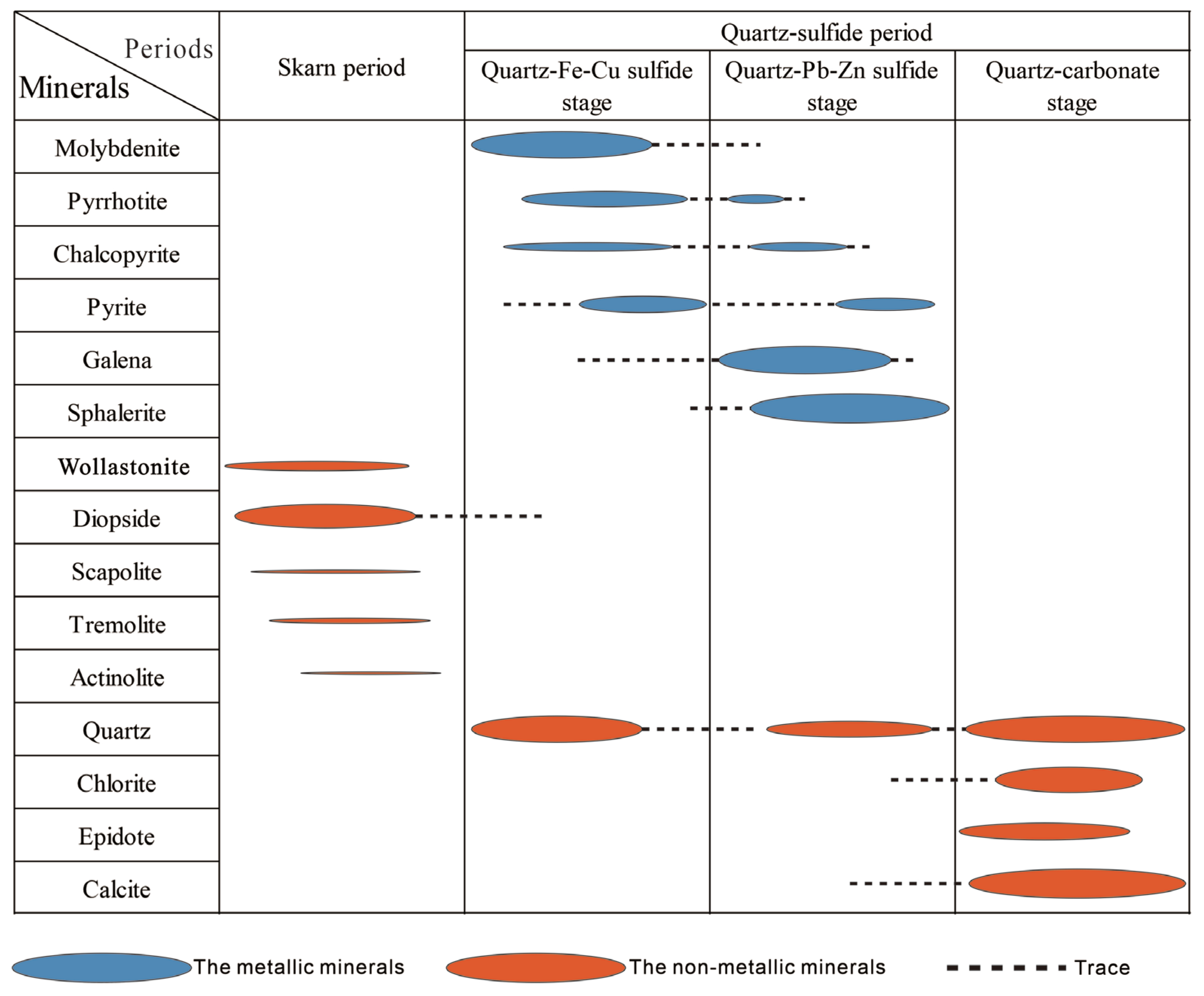
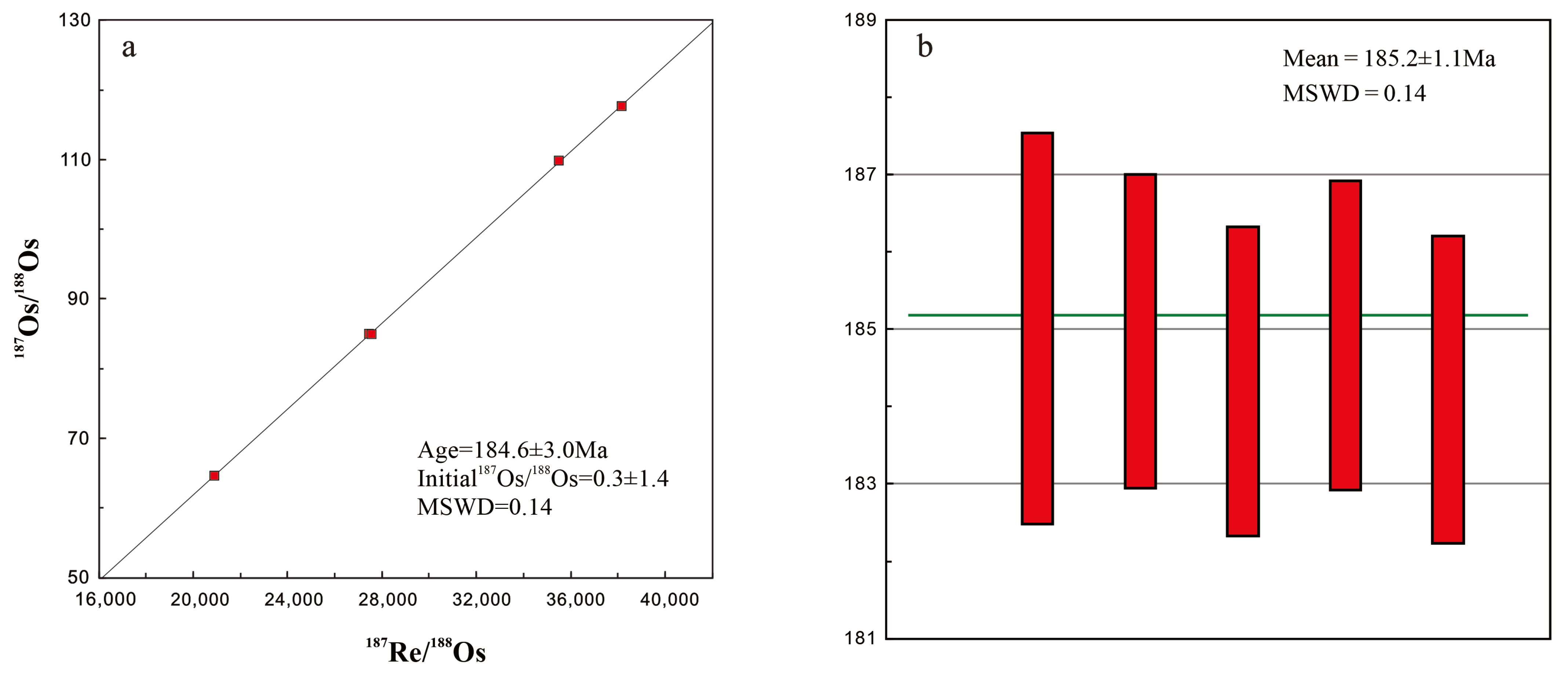
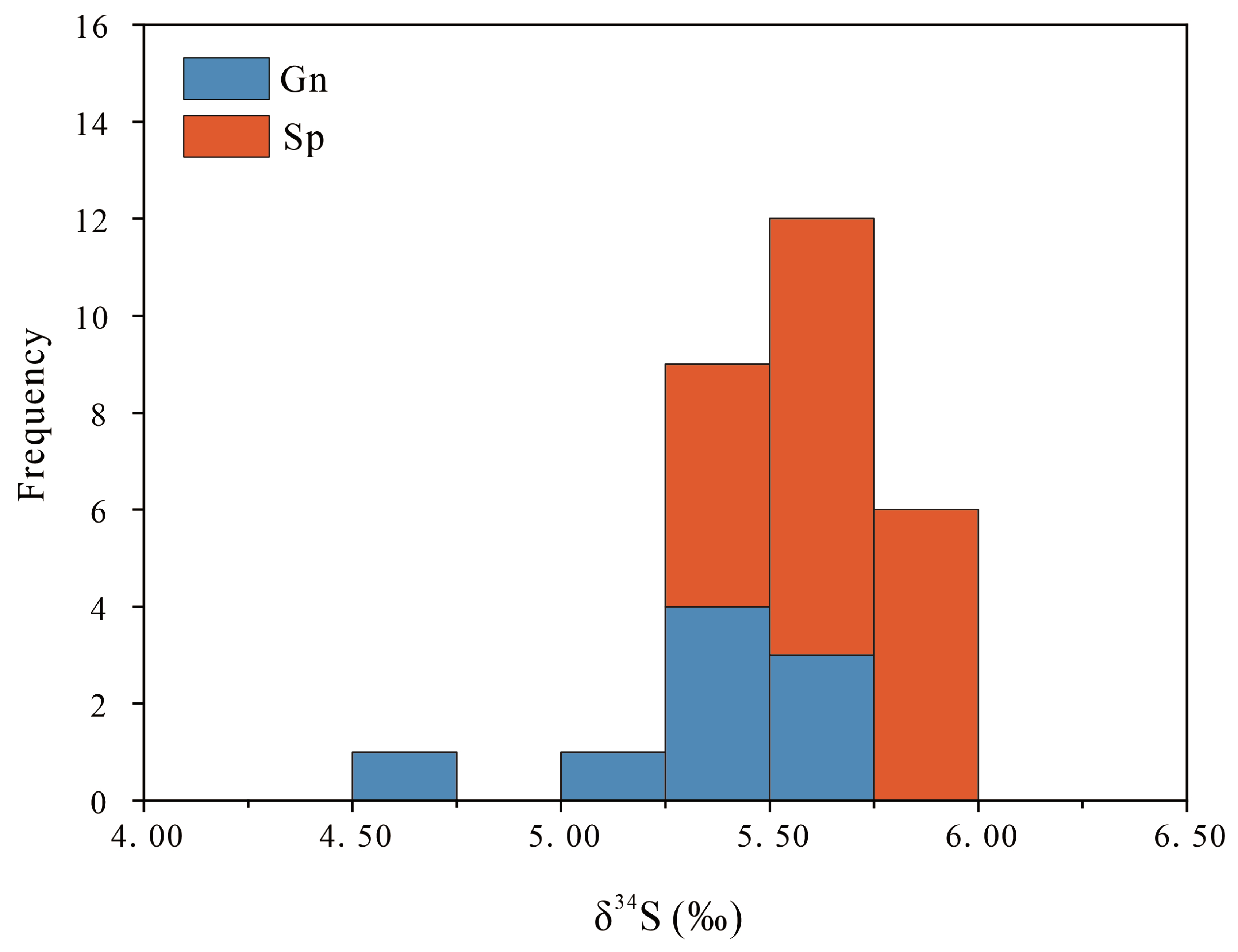

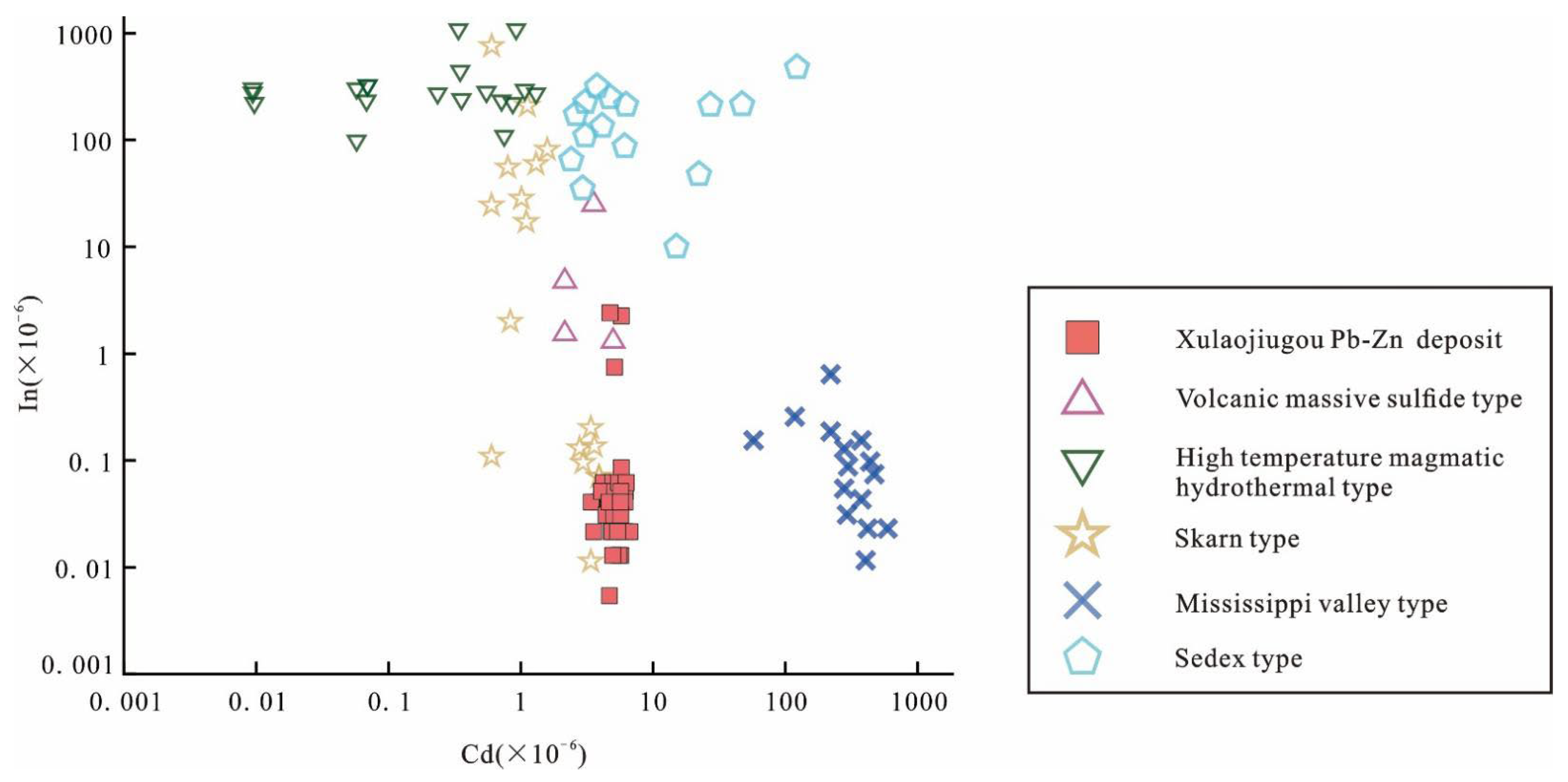

| Sample No. | Ore Type | Mineral Association |
|---|---|---|
| XLJ-3 (1) | massive ore | Gn + Sp + Py + skarn minerals |
| XLJ-3 (2) | submassive ore | Gn + Sp + Ccp + Py + skarn minerals |
| XLJ-3 (3) | submassive ore | Gn + Sp + Po + skarn minerals |
| Sample No. | Weight (g) | Re (μg/g) | Os (ng/g) | 187Re (μg/g) | 187Os (ng/g) | Model Ages (Ma) | |||||
|---|---|---|---|---|---|---|---|---|---|---|---|
| Measured | 2σ | Measured | 2σ | Measured | 2σ | Measured | 2σ | Measured | 2σ | ||
| XLJ-1-1 | 0.01000 | 43.69 | 0.14 | 6.796 | 0.607 | 27.46 | 0.09 | 85.04 | 1.03 | 185.6 | 2.9 |
| XLJ-1-2 | 0.01000 | 56.46 | 0.18 | 0.715 | 0.121 | 35.49 | 0.12 | 109.87 | 0.81 | 185.6 | 2.4 |
| XLJ-1-3 | 0.01000 | 60.70 | 0.20 | 0.894 | 0.081 | 38.15 | 0.13 | 117.64 | 0.84 | 184.8 | 2.3 |
| XLJ-1-5 | 0.01000 | 33.24 | 0.10 | 0.699 | 0.089 | 20.89 | 0.07 | 64.66 | 0.46 | 185.5 | 2.3 |
| XLJ-1-6 | 0.01000 | 43.86 | 0.14 | 1.421 | 0.142 | 27.57 | 0.09 | 84.95 | 0.60 | 184.7 | 2.3 |
| No. | Sulfide | δ34SV-CDT% | 2SE | No. | Sulfide | δ34SV-CDT% | 2SE |
|---|---|---|---|---|---|---|---|
| 1 | Sphalerite | 5.67 | 0.11 | 16 | Sphalerite | 5.39 | 0.11 |
| 2 | Sphalerite | 5.71 | 0.12 | 17 | Sphalerite | 5.55 | 0.13 |
| 3 | Sphalerite | 5.64 | 0.11 | 18 | Sphalerite | 5.47 | 0.13 |
| 4 | Sphalerite | 5.75 | 0.11 | 19 | Sphalerite | 5.50 | 0.13 |
| 5 | Sphalerite | 5.70 | 0.11 | 20 | Sphalerite | 5.63 | 0.13 |
| 6 | Sphalerite | 5.81 | 0.12 | 21 | Galena | 5.56 | 0.15 |
| 7 | Sphalerite | 5.31 | 0.11 | 22 | Galena | 5.52 | 0.16 |
| 8 | Sphalerite | 5.72 | 0.13 | 23 | Galena | 5.47 | 0.17 |
| 9 | Sphalerite | 5.78 | 0.14 | 24 | Galena | 5.68 | 0.15 |
| 10 | Sphalerite | 5.83 | 0.11 | 25 | Galena | 5.31 | 0.15 |
| 11 | Sphalerite | 5.83 | 0.13 | 26 | Galena | 5.46 | 0.14 |
| 12 | Sphalerite | 5.66 | 0.12 | 27 | Galena | 5.15 | 0.14 |
| 13 | Sphalerite | 5.41 | 0.13 | 28 | Galena | 5.27 | 0.15 |
| 14 | Sphalerite | 5.48 | 0.12 | 29 | Galena | 4.70 | 0.19 |
| 15 | Sphalerite | 5.78 | 0.12 |
| Sample No. | Fe | Co | Ni | Cu | Pb | Sb | S | Au | As | Zn | Se | Bi |
|---|---|---|---|---|---|---|---|---|---|---|---|---|
| XLJ-3(1)-1 | 2.38 | 0.02 | 0.01 | - | - | - | 32.50 | - | - | 63.71 | - | 0.15 |
| XLJ-3(1)-2 | 2.33 | 0.02 | - | - | - | - | 32.64 | 0.03 | - | 63.78 | - | 0.12 |
| XLJ-3(1)-3 | 2.35 | 0.04 | - | 0.01 | - | - | 32.39 | - | 0.01 | 63.45 | 0.05 | 0.19 |
| XLJ-3(1)-4 | 2.35 | 0.02 | - | - | - | - | 32.57 | - | - | 63.83 | 0.06 | 0.10 |
| XLJ-3(1)-5 | 2.38 | 0.03 | - | - | - | - | 32.58 | 0.02 | - | 63.96 | 0.02 | 0.12 |
| XLJ-3(1)-6 | 2.32 | 0.02 | - | - | 0.04 | 0.02 | 32.84 | - | - | 64.06 | 0.02 | 0.13 |
| XLJ-3(1)-7 | 2.41 | 0.02 | - | - | - | - | 32.86 | - | - | 64.10 | 0.07 | 0.06 |
| XLJ-3(2)-1 | 2.27 | 0.02 | - | 0.02 | - | - | 32.70 | 0.07 | - | 64.27 | - | 0.14 |
| XLJ-3(2)-2 | 2.29 | 0.02 | - | - | - | - | 32.67 | - | - | 64.35 | - | 0.14 |
| XLJ-3(2)-3 | 2.35 | 0.02 | - | - | 0.01 | - | 32.59 | - | - | 64.47 | 0.04 | 0.11 |
| XLJ-3(2)-4 | 2.35 | 0.02 | - | - | - | - | 32.76 | 0.04 | - | 64.66 | 0.08 | 0.11 |
| XLJ-3(2)-5 | 2.32 | 0.02 | - | - | - | - | 32.79 | - | - | 64.23 | - | 0.10 |
| XLJ-3(2)-6 | 2.38 | 0.03 | - | 0.03 | - | - | 32.75 | 0.01 | - | 64.72 | - | 0.11 |
| XLJ-3(2)-7 | 2.39 | 0.02 | 0.03 | - | - | - | 32.76 | 0.19 | - | 63.86 | - | 0.12 |
| XLJ-3(2)-8 | 2.40 | 0.01 | - | 0.03 | - | - | 32.80 | 0.04 | - | 64.13 | 0.02 | 0.11 |
| XLJ-3(2)-9 | 2.38 | 0.02 | - | - | 0.07 | 0.03 | 32.69 | 0.07 | 0.03 | 64.59 | - | 0.11 |
| XLJ-3(2)-10 | 2.41 | 0.02 | - | 0.01 | 0.01 | - | 32.88 | - | - | 64.37 | 0.02 | 0.11 |
| XLJ-3(2)-11 | 2.40 | 0.02 | - | - | - | - | 32.61 | - | 0.01 | 64.76 | - | 0.06 |
| XLJ-3(2)-12 | 2.37 | 0.02 | - | - | 0.05 | - | 32.48 | 0.04 | - | 64.32 | - | 0.12 |
| XLJ-3(2)-13 | 2.31 | 0.01 | 0.01 | 0.03 | - | - | 32.64 | - | - | 64.68 | 0.02 | 0.07 |
| XLJ-3(2)-14 | 2.34 | 0.02 | - | - | - | - | 32.59 | - | - | 64.22 | 0.01 | 0.14 |
| XLJ-3(2)-15 | 2.36 | 0.04 | 0.01 | - | - | 0.01 | 33.41 | - | - | 64.24 | 0.02 | 0.13 |
| XLJ-3(2)-16 | 2.39 | 0.02 | 0.01 | - | 0.02 | - | 32.74 | 0.08 | - | 64.28 | - | 0.12 |
| XLJ-3(2)-17 | 2.35 | 0.03 | 0.01 | - | 0.04 | - | 32.47 | - | - | 64.07 | 0.02 | 0.11 |
| XLJ-3(2)-18 | 2.40 | 0.02 | 0.00 | - | - | 0.02 | 32.54 | - | - | 63.56 | - | 0.15 |
| XLJ-3(2)-19 | 2.40 | 0.02 | 0.01 | - | - | - | 32.59 | 0.02 | - | 63.84 | 0.02 | 0.10 |
| XLJ-3(2)-20 | 2.41 | 0.03 | - | - | - | - | 32.60 | 0.15 | - | 64.07 | - | 0.09 |
| XLJ-3(2)-21 | 2.43 | 0.02 | 0.01 | - | - | 0.01 | 32.42 | - | - | 63.87 | - | 0.16 |
| XLJ-3(2)-22 | 2.41 | 0.03 | - | - | - | - | 32.43 | 0.04 | - | 63.69 | - | 0.10 |
| XLJ-3(3)-1 | 2.46 | 0.02 | - | - | - | - | 32.31 | - | - | 63.05 | 0.03 | 0.10 |
| XLJ-3(3)-2 | 2.49 | 0.02 | - | - | - | - | 32.41 | 0.04 | - | 63.98 | 0.04 | 0.15 |
| XLJ-3(3)-3 | 2.45 | 0.01 | - | - | - | - | 32.51 | 0.02 | - | 63.97 | - | 0.17 |
| XLJ-3(3)-4 | 2.47 | 0.02 | - | - | - | 0.01 | 32.36 | - | 0.04 | 63.66 | - | 0.16 |
| XLJ-3(3)-5 | 2.50 | 0.03 | - | - | - | - | 32.03 | 0.02 | 0.01 | 63.00 | 0.02 | 0.11 |
| XLJ-3(3)-6 | 2.45 | 0.02 | - | - | - | - | 32.47 | 0.02 | - | 63.80 | - | 0.15 |
| XLJ-3(3)-7 | 2.43 | 0.02 | - | - | - | 0.01 | 32.47 | - | - | 64.12 | 0.01 | 0.10 |
| XLJ-3(3)-8 | 2.44 | 0.03 | 0.01 | - | - | - | 32.58 | - | - | 64.37 | - | 0.08 |
| XLJ-3(3)-9 | 2.46 | 0.02 | - | 0.01 | - | - | 32.63 | 0.03 | 0.05 | 63.87 | 0.04 | 0.16 |
| XLJ-3(3)-10 | 2.44 | 0.02 | - | - | 0.02 | 0.01 | 32.44 | 0.02 | - | 63.79 | 0.01 | 0.10 |
| XLJ-3(3)-11 | 2.43 | 0.02 | 0.01 | - | 0.03 | - | 32.44 | - | - | 63.10 | - | 0.12 |
| XLJ-3(3)-12 | 2.50 | 0.03 | - | 0.01 | - | - | 32.40 | - | - | 63.75 | 0.03 | 0.11 |
| XLJ-3(3)-13 | 2.54 | 0.03 | - | - | - | - | 32.52 | 0.01 | - | 63.44 | - | 0.05 |
| XLJ-3(3)-14 | 2.40 | 0.02 | 0.02 | - | - | - | 32.60 | - | 0.02 | 64.50 | 0.01 | 0.10 |
| XLJ-3(3)-15 | 2.46 | 0.04 | 0.01 | - | - | 0.00 | 32.66 | 0.04 | 0.02 | 63.98 | - | 0.10 |
| XLJ-3(3)-16 | 2.35 | 0.02 | - | - | - | 0.00 | 32.58 | - | - | 64.51 | - | 0.11 |
| XLJ-3(3)-17 | 2.37 | 0.02 | - | - | - | - | 31.88 | - | - | 63.41 | - | 0.11 |
| XLJ-3(3)-18 | 2.46 | 0.03 | - | - | - | 0.01 | 32.91 | - | - | 64.13 | - | 0.12 |
| XLJ-3(3)-19 | 2.43 | 0.03 | - | - | - | - | 32.74 | 0.01 | - | 64.40 | - | 0.10 |
| XLJ-3(3)-20 | 2.48 | 0.02 | 0.01 | - | - | - | 32.58 | - | - | 64.41 | - | 0.12 |
| XLJ-3(3)-21 | 2.45 | 0.02 | - | 0.01 | - | - | 32.63 | - | - | 64.30 | - | 0.05 |
| Sample No. | Mn | Fe | Zn | Ni | Cu | Co | Ga | Ge | As | Se | Ag | Cd | In | Sn | Sb | Bi | Pb |
|---|---|---|---|---|---|---|---|---|---|---|---|---|---|---|---|---|---|
| XLJ-3-1-02 | 3253 | 19,285 | 643,114 | 11.0 | 21.9 | 161 | 0.01 | 5.29 | 18.5 | 554 | 3.81 | 2884 | 0.02 | 0.15 | 0.04 | 0.19 | 2.58 |
| XLJ-3-1-03 | 3163 | 19,234 | 642,384 | 3.99 | 20.6 | 160 | 0.92 | 5.81 | 5.19 | 651 | 4.20 | 2862 | 0.03 | 1.09 | 0.37 | 0.31 | 5.02 |
| XLJ-3-1-04 | 3237 | 18,707 | 642,977 | 11.0 | 24.7 | 155 | 0.07 | 4.84 | 6.04 | 599 | 4.43 | 2860 | 0.03 | - | 0.46 | 2.93 | 6.03 |
| XLJ-3-1-05 | 3486 | 18,434 | 640,386 | 5.02 | 22.8 | 156 | 0.09 | 5.52 | 2.22 | 534 | 4.26 | 2819 | 0.02 | 0.60 | 1.39 | 2.27 | 10.43 |
| XLJ-3-1-06 | 2977 | 18,587 | 642,147 | 5.70 | 22.1 | 158 | 0.39 | 4.04 | 2.86 | 574 | 4.22 | 2780 | 0.05 | 0.11 | 0.96 | 1.30 | 67 |
| XLJ-3-1-07 | 3048 | 18,768 | 642,846 | - | 22.1 | 160 | 0.07 | 5.03 | 5.87 | 559 | 6.10 | 2756 | 0.03 | 0.60 | 2.82 | 2.89 | 73.6 |
| XLJ-3-1-08 | 3707 | 18,989 | 638,269 | 17.2 | 25.3 | 160 | 0.40 | 5.91 | 6.36 | 565 | 4.08 | 2809 | 0.03 | 0.68 | 0.26 | 0.24 | 26.6 |
| XLJ-3-1-09 | 3100 | 18,188 | 642,457 | 5.30 | 22.4 | 159 | 0.30 | 4.94 | 13.1 | 494 | 3.97 | 2814 | 0.07 | - | 0.64 | 1.14 | 9.76 |
| XLJ-3-1-10 | 2882 | 17,874 | 645,080 | - | 21.1 | 155 | 0.09 | 5.43 | 9.20 | 492 | 3.86 | 2760 | 0.05 | 0.39 | 0.04 | 0.16 | 14.6 |
| XLJ-3-1-11 | 3078 | 18,669 | 642,176 | 12.5 | 23.9 | 171 | 0.43 | 5.39 | 13.4 | 572 | 4.16 | 2841 | 0.02 | 0.41 | 0.82 | 1.24 | 39.5 |
| XLJ-3-1-12 | 2937 | 19,720 | 637,922 | - | 18.2 | 163 | 0.16 | 6.26 | 5.18 | 441 | 5.01 | 2805 | 0.03 | 0.74 | 1.61 | 4.10 | 64.2 |
| XLJ-3-1-13 | 3036 | 18,343 | 641,697 | - | 23.4 | 170 | 0.00 | 5.89 | 13.6 | 410 | 4.82 | 2878 | 0.06 | 1.03 | 0.83 | 5.06 | 38.4 |
| XLJ-3-1-19 | 2950 | 18,670 | 644,370 | - | 20.8 | 167 | 0.24 | 5.10 | 8.31 | 599 | 4.90 | 2881 | 0.06 | 0.12 | 0.15 | 0.53 | 8.08 |
| XLJ-3-1-20 | 3042 | 19,111 | 643,288 | 11.1 | 25.4 | 162 | 0.19 | 5.54 | 0.63 | 534 | 4.23 | 2762 | 0.09 | 0.00 | 0.02 | 0.12 | 4.40 |
| XLJ-3-1-21 | 2587 | 18,966 | 640,488 | 13.3 | 22.6 | 165 | 0.11 | 5.55 | 10.66 | 506 | 4.65 | 2951 | 1.23 | 0.64 | 0.17 | 3.27 | 673 |
| XLJ-3-1-22 | 3332 | 19,423 | 638,980 | - | 18.9 | 168 | 0.32 | 4.90 | 2.6 | 506 | 4.29 | 3028 | 0.05 | 0.09 | 0.07 | 2.25 | 611 |
| XLJ-3-1-23 | 3006 | 18,654 | 643,090 | 16.2 | 20.6 | 164 | 0.25 | 4.72 | 12.1 | 517 | 4.18 | 2730 | 0.01 | 1.50 | 0.59 | 0.87 | 27.25 |
| XLJ-3-2-24 | 2932 | 17,619 | 644,215 | 12.5 | 18.3 | 153 | 0.04 | 4.86 | 8.77 | 767 | 3.73 | 2897 | 0.03 | 0.41 | 0.06 | 0.07 | 1.51 |
| XLJ-3-2-25 | 2971 | 18,694 | 642,250 | 13.8 | 23.7 | 155 | 0.23 | 4.64 | 8.15 | 689 | 4.77 | 2858 | 0.04 | 0.26 | - | 0.43 | 8.61 |
| XLJ-3-2-27 | 3103 | 20,854 | 642,076 | 18.9 | 19.9 | 157 | 0.17 | 4.63 | 9.71 | 533 | 3.78 | 2984 | 0.05 | - | 0.21 | 0.30 | 3.50 |
| XLJ-3-2-28 | 3536 | 21,325 | 637,511 | 0.16 | 20.3 | 159 | 0.47 | 5.31 | 10.5 | 614 | 4.24 | 2922 | 0.06 | 0.76 | 1.12 | 3.16 | 11.6 |
| XLJ-3-2-29 | 2888 | 22,584 | 639,519 | 18.4 | 29.9 | 152 | 0.26 | 4.75 | 11.6 | 755 | 3.88 | 2909 | 1.30 | 0.42 | 0.31 | 0.84 | 2.61 |
| XLJ-3-2-30 | 2972 | 23,390 | 636,835 | - | 21.8 | 158 | 0.26 | 5.50 | 5.43 | 784 | 3.85 | 3026 | 0.04 | 0.21 | 2.23 | 0.13 | 1.82 |
| XLJ-3-2-31 | 2831 | 23,552 | 639,225 | 9.36 | 20.0 | 154 | 0.21 | 5.29 | 12.9 | 709 | 3.72 | 2917 | 0.03 | 0.06 | 0.12 | 0.22 | 3.29 |
| XLJ-3-2-32 | 2811 | 25,770 | 634,938 | 1.98 | 9.2 | 155 | 0.54 | 5.19 | 8.12 | 352 | 3.50 | 2996 | 0.06 | 0.13 | 0.01 | 0.03 | 1.21 |
| XLJ-3-2-33 | 3042 | 26,364 | 634,222 | 8.89 | 10.9 | 158 | 0.51 | 4.87 | 10.7 | 702 | 3.44 | 3046 | 0.05 | 0.00 | 0.07 | 0.15 | 9.67 |
| XLJ-3-2-34 | 3010 | 26,983 | 630,068 | - | 20.6 | 159 | 0.18 | 4.48 | 12.1 | 871 | 3.86 | 3023 | 0.04 | 0.61 | 0.16 | 1.12 | 245 |
| XLJ-3-2-35 | 2816 | 28,123 | 634,343 | 10.7 | 19.8 | 156 | 0.02 | 5.00 | 7.21 | 814 | 3.58 | 3009 | 0.06 | - | - | 0.08 | 2.51 |
| XLJ-3-2-36 | 3235 | 28,074 | 631,627 | 17.5 | 20.3 | 159 | 0.38 | 5.06 | 9.79 | 738 | 3.55 | 2985 | 0.51 | 0.63 | 0.13 | 0.25 | 3.07 |
| XLJ-3-2-37 | 2870 | 28,660 | 631,176 | 18.7 | 23.1 | 159 | 0.13 | 5.88 | 15.0 | 745 | 3.54 | 2940 | 0.06 | 0.60 | 0.20 | 0.23 | 8.04 |
| XLJ-3-3-38 | 3201 | 19,195 | 638,762 | 7.52 | 18.8 | 152 | 0.24 | 3.79 | 6.73 | 533 | 5.11 | 3058 | 0.03 | 0.27 | 0.44 | 4.73 | 18.3 |
| XLJ-3-3-39 | 3357 | 19,306 | 638,127 | 5.94 | 19.0 | 156 | 0.26 | 4.22 | 4.79 | 601 | 4.13 | 2830 | 0.06 | 0.30 | 0.20 | 1.14 | 9.41 |
| XLJ-3-3-40 | 2899 | 18,451 | 642,986 | 3.45 | 20.2 | 150 | 0.33 | 5.07 | 15.3 | 534 | 5.33 | 2762 | 0.06 | 0.36 | 0.35 | 3.63 | 190 |
| XLJ-3-3-41 | 3327 | 19,449 | 636,660 | 19.5 | 21.1 | 158 | 0.29 | 4.99 | 4.57 | 576 | 4.08 | 2808 | 0.04 | 0.40 | 0.47 | 1.83 | 102 |
| XLJ-3-3-42 | 2659 | 19,259 | 642,972 | 2.68 | 23.3 | 157 | 0.14 | 5.34 | 10.3 | 544 | 5.17 | 3072 | 0.07 | 0.18 | 0.61 | 3.64 | 19.2 |
| XLJ-3-3-43 | 2852 | 20,096 | 641,224 | 7.42 | 20.5 | 159 | 0.39 | 4.92 | 3.33 | 547 | 4.41 | 2956 | 0.02 | 0.66 | 0.16 | 0.66 | 6.06 |
| XLJ-3-3-44 | 2546 | 19,864 | 642,870 | 12.6 | 20.2 | 163 | 0.11 | 5.97 | 9.70 | 537 | 3.79 | 2982 | 0.07 | 0.16 | 0.12 | 0.56 | 5.56 |
| XLJ-3-3-45 | 2543 | 19,730 | 641,591 | 16.1 | 20.4 | 158 | 0.09 | 5.52 | 7.37 | 498 | 3.88 | 3000 | 0.06 | 0.56 | 0.09 | 0.00 | 2.03 |
| XLJ-3-3-46 | 2464 | 20,433 | 642,494 | 9.64 | 12.9 | 162 | 0.48 | 4.69 | 1.60 | 377 | 3.56 | 2948 | 0.05 | 0.27 | 0.01 | 0.05 | 0.63 |
| XLJ-3-3-47 | 2993 | 19,532 | 639,763 | - | 25.4 | 159 | 0.51 | 5.85 | 15.2 | 594 | 4.04 | 2841 | 0.05 | 0.61 | 0.52 | 1.19 | 10.2 |
| XLJ-3-3-48 | 3174 | 20,511 | 635,860 | 5.57 | 19.0 | 160 | 0.43 | 5.51 | 2.37 | 582 | 4.33 | 2903 | 0.04 | 0.33 | 0.76 | 2.83 | 33.1 |
| XLJ-3-3-49 | 3782 | 21,072 | 630,447 | 12.3 | 20.4 | 161 | 0.33 | 5.49 | 7.84 | 609 | 4.27 | 2917 | 0.05 | 0.22 | 0.44 | 1.30 | 11.8 |
| Deposit | Lithology | Sample Analyzed | Analytical Method | Age (Ma) | References |
|---|---|---|---|---|---|
| Xulaojiugou | medium-grained monzogranite | Molybdenite | Re–Os | 184.6 ± 3.0 | This study |
| medium-grained monzogranite | Zircon | U-Pb | 181.2 ± 1.1 | [13] | |
| porphyritic biotite granite | Zircon | U-Pb | 179.9 ± 1.0 | ||
| Luming | monzogranite | Zircon | U-Pb | 180.7 ± 1.6 | [13] |
| Huojihe | monzogranite | Zircon | U-Pb | 186 ± 1.7 | [15,29] |
| porphyritic granite | Zircon | U-Pb | 176.3 ± 5.1 | ||
| Cuihongshan | porphyritic granite | Zircon | U-Pb | 196.5–193.7 | [18] |
| Xiaoxilin | granodiorite | Zircon | U-Pb | 200 ± 2 | [30] |
| Ergu | biotite granodiorite | Zircon | U-Pb | 186.5 ± 5 | [31] |
Disclaimer/Publisher’s Note: The statements, opinions and data contained in all publications are solely those of the individual author(s) and contributor(s) and not of MDPI and/or the editor(s). MDPI and/or the editor(s) disclaim responsibility for any injury to people or property resulting from any ideas, methods, instructions or products referred to in the content. |
© 2025 by the authors. Licensee MDPI, Basel, Switzerland. This article is an open access article distributed under the terms and conditions of the Creative Commons Attribution (CC BY) license (https://creativecommons.org/licenses/by/4.0/).
Share and Cite
Liu, G.; Ren, Y.; Li, J.; Xu, W. Origin of the Xulaojiugou Pb–Zn Deposit, Heilongjiang Province, NE China: Constraints from Molybdenite Re–Os Isotopic Dating, Trace Elements, and Isotopic Compositions of Sulfides. Minerals 2025, 15, 441. https://doi.org/10.3390/min15050441
Liu G, Ren Y, Li J, Xu W. Origin of the Xulaojiugou Pb–Zn Deposit, Heilongjiang Province, NE China: Constraints from Molybdenite Re–Os Isotopic Dating, Trace Elements, and Isotopic Compositions of Sulfides. Minerals. 2025; 15(5):441. https://doi.org/10.3390/min15050441
Chicago/Turabian StyleLiu, Gan, Yunsheng Ren, Jingmou Li, and Wentan Xu. 2025. "Origin of the Xulaojiugou Pb–Zn Deposit, Heilongjiang Province, NE China: Constraints from Molybdenite Re–Os Isotopic Dating, Trace Elements, and Isotopic Compositions of Sulfides" Minerals 15, no. 5: 441. https://doi.org/10.3390/min15050441
APA StyleLiu, G., Ren, Y., Li, J., & Xu, W. (2025). Origin of the Xulaojiugou Pb–Zn Deposit, Heilongjiang Province, NE China: Constraints from Molybdenite Re–Os Isotopic Dating, Trace Elements, and Isotopic Compositions of Sulfides. Minerals, 15(5), 441. https://doi.org/10.3390/min15050441





